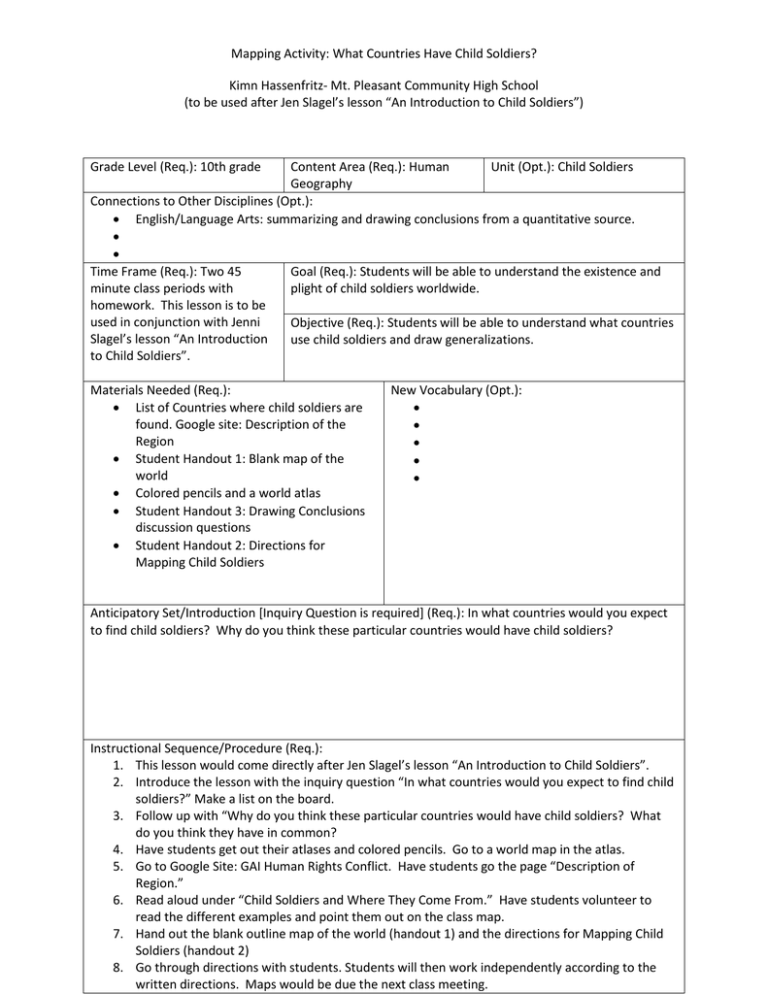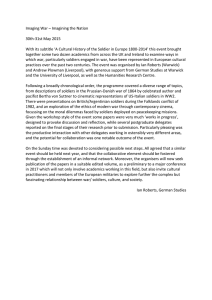Mapping Activity: What Countries Have Child Soldiers?
advertisement

Mapping Activity: What Countries Have Child Soldiers? Kimn Hassenfritz- Mt. Pleasant Community High School (to be used after Jen Slagel’s lesson “An Introduction to Child Soldiers”) Grade Level (Req.): 10th grade Content Area (Req.): Human Unit (Opt.): Child Soldiers Geography Connections to Other Disciplines (Opt.): • English/Language Arts: summarizing and drawing conclusions from a quantitative source. • • Time Frame (Req.): Two 45 Goal (Req.): Students will be able to understand the existence and minute class periods with plight of child soldiers worldwide. homework. This lesson is to be used in conjunction with Jenni Objective (Req.): Students will be able to understand what countries Slagel’s lesson “An Introduction use child soldiers and draw generalizations. to Child Soldiers”. Materials Needed (Req.): • List of Countries where child soldiers are found. Google site: Description of the Region • Student Handout 1: Blank map of the world • Colored pencils and a world atlas • Student Handout 3: Drawing Conclusions discussion questions • Student Handout 2: Directions for Mapping Child Soldiers New Vocabulary (Opt.): • • • • • Anticipatory Set/Introduction [Inquiry Question is required] (Req.): In what countries would you expect to find child soldiers? Why do you think these particular countries would have child soldiers? Instructional Sequence/Procedure (Req.): 1. This lesson would come directly after Jen Slagel’s lesson “An Introduction to Child Soldiers”. 2. Introduce the lesson with the inquiry question “In what countries would you expect to find child soldiers?” Make a list on the board. 3. Follow up with “Why do you think these particular countries would have child soldiers? What do you think they have in common? 4. Have students get out their atlases and colored pencils. Go to a world map in the atlas. 5. Go to Google Site: GAI Human Rights Conflict. Have students go the page “Description of Region.” 6. Read aloud under “Child Soldiers and Where They Come From.” Have students volunteer to read the different examples and point them out on the class map. 7. Hand out the blank outline map of the world (handout 1) and the directions for Mapping Child Soldiers (handout 2) 8. Go through directions with students. Students will then work independently according to the written directions. Maps would be due the next class meeting. 9. Day 2 10. Bell –ringer to review what covered the day before: Rapid Review. (Formative assessment) 11. Put students in small groups of three. Have them bring their graphic organizers on Causes and Effects of Child Soldiers and the map of Child Soldiers. 12. Distribute (handout 3) Drawing Conclusions. 13. Students are required to answer the questions in complete sentences and with explanation using their student generated materials. 14. Students in each group are required to write the same answers (so everyone is engaged), staple their papers together and hand in as one. 15. One possible way to assess formatively is to have the teacher choose one paper to evaluate and everyone in the group receives the same grade. 16. 17. 18. 19. 20. Formative Evaluation (Req.): Start the period with Assessment (Req.): Formal assessment would take Rapid Review to check comprehension from the place with a test or project at the end of the unit. day before. Use the map of Child Soldiers and the graphic organizer (Slagel) on Causes and Effects of Child Soldiers to answer discussion questions in groups. Iowa Core Curriculum Standards Used (Req.): • Behavioral Sciences, grade 9-12: Understand current social issues to determine how the individual is able to formulate opinions and responses to those issues. • Behavioral Sciences, grade 9-12: Understand how social status, social groups, social change, and social institutions influence individual and group behaviors. • Geography, grade 9-12: Understand the use of geographic tools to locate and analyze information about people, places, and environments. • • • • • • • Common Core Curriculum Standards Used (Opt.): • Writing for Literacy in History/Social Studies, grade 6-12: Write informative/explanatory texts, including the narration of historical events. • Reading Standards for Literacy in History/Social Studies, grade 6-12: Integrate quantitative or technical analysis (e.g.,charts, research data) with qualitative analysis in print or digital text. • • • NGS Standards Used (Req.): • How to use maps and other geographic representations, tools, an technologies to acquire, process, and report information from a spatial perspective. Related themes: Location , Place • How the forces of cooperation and conflict among people influence the division and control of Earth’s surface. Related themes: Regions, Movement, Human/Environment Interaction • • • • • • • • Five Themes of Geography Used (Req.): • Location • Place • Regions • Movement • Human/Environment Interaction 21st Century Universal Constructs (Opt.): School District Standards and Benchmarks (Opt.): • • • Other Disciplinary Standards (Opt.): • • • • • Other Essential Information (Opt.): Other Resources (Opt.): • https://sites.google.com/a/mtpcsd.org/gai-human-rights-conflict/ • • • Cross Curricular Connections: Jennifer Slagel and I have worked collaboratively to create the first two lessons in a unit on child labor and child soldiers around the globe. The lessons are intended to be used together, one right after the other. These two lessons will be utilized in the next academic year in a new, required course covering Human Geography. In the first lesson Ms. Slagel has the students viewing a video and completing a graphic organizer on the causes and effects of child soldiers. The subsequent lesson I have designed is to map the countries where child soldiers are used. After the mapping is complete, which also requires students to view the United Nations document on the Optional Protocol to the Convention on the Rights of the Child on the Involvement of Children in Armed Conflict, they will be asked to draw conclusions and make summary statements based on the map and the graphic organizer of causes and effects. Drawing conclusions, in this case from quantitative material, and making summary statements is an initiative our entire faculty and all curricular areas have been working on for several years now. This lesson, and indeed the entire unit, would fit in perfectly with the English curriculum as students could read the nonfiction book a long way gone: Memoirs of a Boy Soldier by Ishmael Beah or any other accounts by former child soldiers. Another extension of these lessons could be to assign students a country where children are used as soldiers and research the conflict and particular reasons why children are being involved there. RAPID REVIEW: R Date Name ____________________________# ____ Word and definition/Question and answer Word:__________________________________________________________ Definition__________________________________________________ Question:_______________________________________________________ Answer ______________________________________________________ ______________________________________________________ Word:__________________________________________________________ Definition__________________________________________________ Question:_______________________________________________________ Answer ______________________________________________________ ______________________________________________________ Word:__________________________________________________________ Definition__________________________________________________ Question:_______________________________________________________ Answer ______________________________________________________ ______________________________________________________ Word:__________________________________________________________ Definition__________________________________________________ Question:_______________________________________________________ Answer ______________________________________________________ ______________________________________________________ Mapping Child Soldiers Handout 1 Name _______________________# ___ Directions: Using a blank map of the world, an atlas and the Google Site GAI Hum an R ights Conflict https:/ / sites.google.com / a/ m tpcsd.org/ gai-hum an-rightsconflict/ description-of-the-region follow the step-by-step directions below. Step #1 Open the Google Site GAI Human Rights Conflict. Go the tab entitled “Description of the Region”. Read Child Soldiers and where they come from. Step#2 Using your atlas and a blank outline map of the world, map the data under Countries using Child Soldiers. Title your map: “Child Soldiers Fighting in Organized Conflicts”. Locate and with a black pen, label the countries on your map that use child soldiers Shade the countries by continent (do not color in black or red). Create a key. Step #3 Consult the Google site under the heading of Optional Protocol to the Convention on the Rights of the Child on the Involvement of Children in Armed Conflict. Read the information on the treaty and open the link to see what countries have ratified the agreement. Determine which countries have signed the agreement but still have child soldiers in their countries. Locate these countries and stripe them with red. Be sure to make a striped box for your key. Label this box “Countries who continue to use child soldiers despite signing an agreement not to.” Mapping Child Soldiers Drawing Conclusions: Handout 3 Name _______________________# ___ Directions: Using your maps of Child Soldiers and the graphic organizer on the Causes and Effects of Child Soldiers, answer the following questions. Be sure to write in complete sentences. You must have an explanation for each of your answers (other than #1 and #2). 1. Which continents appear to have the most countries where there are conflicts involving child soldiers? 2. Which continents other than Antarctica have no child soldiers? 3. In the countries where children are forced to fight, what do these countries have in common? 4. What might the social and political conditions be like in countries in which rebel groups or governments rely on children as combatants? 5. Why might some children voluntarily turn to soldiering? 6. Why are these children not protected by adults or their governments? 7. Why would a country sign the document outlawing child soldiers and then still have it take place in their country? 8. Should those countries that continue to have child soldiers, although they have signed the treaty not to, be punished? If so, how? 9. Any adult who committed the atrocities some of these children have would be charged with war crimes against humanity. Should child soldiers be considered victims or criminals? Why?




